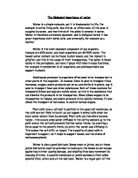Due to the hydrogen bonds in water it becomes an unusual substance that is able to act as a solvent, a reactant, as a molecule with a cohesive properties, as an environment and as a temperature stabiliser
Water can dissolve polar or ionic substances and can keep them in solution because of water's own polar properties. We call substances that dissolve in water hydrophilic substances. For example ionic substances such as sodium chloride, NaCl, which are made up of positive and negative ions are held in its structure by the strong attraction between it's positive sodium ions and negative chloride ions. Normally these ionic attractions require a large amount of energy to break but when put into water the negative oxygen side of the water molecules cluster around the positive sodium ions Na+ and the positive hydrogen atoms cluster around the negative chloride ions Cl-. As the ions are separated the attraction between the Na+ and Cl- ions is weakened. Hydrogen bonds can also be formed between water and the polar hydroxyl groups of covalently bonded molecules such as glucose. These bonds pull and separate the molecules from each other.
Another importance of water is that as a solvent it is vital for most biochemical reactions such as respiration. This is why cell cytoplasm contains about 90% water. Because water cannot dissolve hydrophobic substances such as fats and oils, it makes them good at waterproofing organisms and as cell membranes.
The thermal properties of water are also interesting because they are unlike other molecules. Water has a boiling point of 100°c and a melting point of 0°c. This is unusual for a molecule of its size as other molecules with similar properties are all gaseous at room temperature whereas water is a liquid. It is the hydrogen bonds that hold water molecules in a liquid store. It takes a lot of heat energy to be able to raise the temperature of water significantly, but once warm it cools slowly. This is an advantage to creatures where a constant body temperature has to be maintained. This constant temperature with very little change will remain in large amounts of water.
A large amount of bonds holding water molecules together requires a considerable amount of energy to separate the bonds and turn the liquid to favour. This is called having a high latent heat of evaporation. Animals use this property of water by using excess body heat to evaporate water from their surfaces.
Water also has a high latent heat of fusion from solid to liquid. This is vital in the case of cytoplasm in cells, which is made of a high percentage of water because once frozen the cell would be irreparably damaged. The freezing point of water is also lowered by solutes because the soluble molecules disrupt the hydrogen bonds making the water freeze at a lower temperature and it easier to melt ice. As there are many solutes in cytoplasm the water will not freeze until well below 0oC and the cells are protected until the temperature gets extremely low.
The density of water increases as it cools and the hydrogen bonds between the water molecules take on a more latticed formation as ice. Yet ice floats on the surface of water which means its density must be lower than that of water. Water is at it's most dense at 4oC which is when its bonds are closest together. When water freezes the lattice arrangement of its structure move apart slightly and it floats on the surface. This means that the layer of ice insulates the water below that stays at 4oC and aquatic life can continue.
Water is key in condensation reactions with many sugars and carbohydrates. However adding water can split molecules and the process is known as hydrolysis.
A process done by humans and animals called respiration produces water as a by-product. Plants also use it for photosynthesis therefore without water neither of these two processes would happen and life on earth would not exist. Also water is transparent allowing aquatic plants to photosynthesis and other organisms to live.
The hydrogen bonds between the molecules make water highly cohesive. Water is formed into spherical droplets which have the maximum inner area and least surface area when in contact with a hydrophobic material. It means that the water molecules where the water meets the air will be tightly held together and the water molecules below them to form an elastic film known as surface tension. Small creatures can get stuck in the surface water because they cannot break the water surface tension, creatures like water skaters can move across the surface of the water without sinking as they have hydrophobic feet which stops them from breaking the surface tension.
Water is incompressible due to strong hydrostatic forces. As a result of this soft-bodied creatures such as worm and jellyfish do not require a skeletal system for support. Water allows cells filled with water to become turgid and due to its incompressibility plants can support themselves.
In conclusion water's unique properties make it perhaps the most biologically important substance on the planet. No other substance shares similar properties to water and in the way that one single molecule can possess such varied and essential characteristics.







